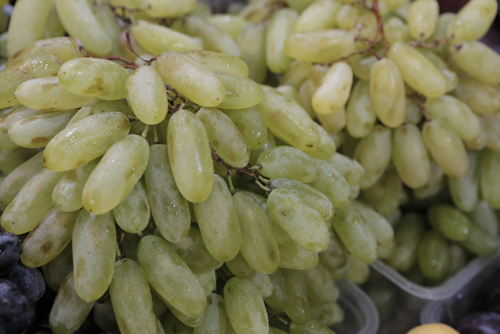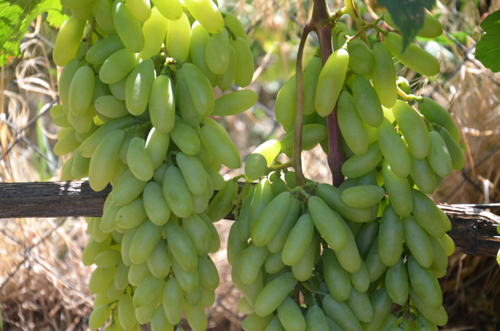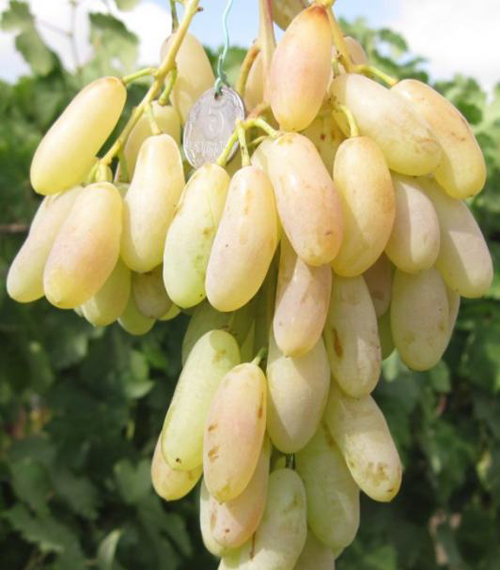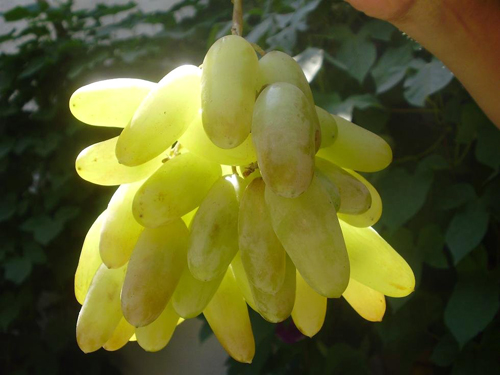Grape variety Ladies fingers (Husayne white)
Husayne white is an ancient oriental grape variety, in the former USSR, which spread mainly in the Central Asian republics, and is known mainly by its market name - Ladies fingers. The variety turned out to be so popular that over time, its name became a household name, and almost all varieties with an elongated shape of berries were often called "Ladies' fingers".

This grape originated from the irrigated regions of the oasis culture of Western and Central Asia. According to the researchers, he was born as a result of multiple sowing of seeds, followed by careful artificial selection of seedlings in several generations. And today, if you sow self-pollinated seeds of Husayne, you can most likely get plants that are very similar to the parental form. This indicates a high genetic stability and varietal traits established over many centuries, fixed in DNA.
The appearance of this variety in Uzbekistan is associated with the arrival of the Turkic tribes there, after which the active cultivation of high-quality table grapes began on these lands, as well as varieties of "sun berry" intended for drying and making concentrates. Gradually Ladies' fingers began to spread beyond Central Asia - to the Lower Volga region, the North Caucasus and Transcaucasia, Crimea, and even to Bulgaria. In the Volgograd and Astrakhan Regions, as well as in the Stavropol Territory, it is known under the name "Bokalny", in Azerbaijan and Armenia as "Itsaptuk", in Dagestan - as "Shah Raisin" or "Kahrabi", in Bulgaria - "Huseyn Byalo" or "Damski please ".
In Uzbekistan, where our hero is most widespread, a number of its clonal varieties are distinguished, differing in the shape of the berry: Husaine Kelim Barmak, H. Lunda, H. Murchamion, H. Kalta and H. Begizi. However, these variations are very arbitrary, since grapes can differ on the same plant and even bunches. Actually, the classic "Ladies fingers" is Husayne Kelim Barmak, while the rest of the grape clones are distinguished by a shorter berry length.
Currently, thousands of hectares are occupied under the variety, mainly in the Central Asian republics, where, thanks to a suitable climate, it shows its best qualities. It is appreciated for its excellent appearance and taste of the fruit, excellent transportability, due to which it can be transported thousands of kilometers without losing its marketable form, as well as for its good plasticity for eastern varieties, which allows it to satisfactorily acclimatize in new regions.

Agrobiological characteristics
The bushes are quite vigorous. Young leaves have a light crimson shade, light cobweb pubescence on one side, and bristly on the other. The formed leaves are thin and curved with raised edges, yellowish-green in color with light, and at the base reddish veins, medium or large in size (16-20 × 12-19 cm), rounded or slightly elongated in length, three- and five-lobed, dissected medium. The surface of the leaf blade of grapes is smooth, the back side is covered with bristly-cobweb pubescence of weak or medium intensity. The upper side cuts are deep, can be either open, lyre-shaped with a rounded or pointed bottom, or closed with a narrow elliptical opening. The lower notches are small, V-shaped or barely outlined, sometimes completely absent. The petiole is open, broadly vaulted or lancet with a flat or pointed bottom. The petiole is glabrous, green in color with a pink patch in the middle, shorter in length than the central vein of the leaf. The denticles along the edge of the leaf blade are heterogeneous in size, triangular or saw-shaped, with curved edges and rounded apices.The flowers of the variety are bisexual, with an excellent ability to pollinate with their own pollen and, for this reason, there is no tendency to pea or excessive loosening of the bunch. Young shoots of Ladies' fingers are green, internodes are colored several shades darker than the locations of the nodes. Ripe vine changes color to brown or light brown. The maturation of one-year growth occurs, although at a relatively late date, but, nevertheless, quite well (75-80%). On the Black Sea coast of the North Caucasus with a mild subtropical climate, 100% ripening of vines is noted. The autumn color of grape leaves before leaf fall is lemon yellow.
Bunches of all varieties of Husayne white can grow very large: from 18 to 50 cm long, up to 25 cm wide. The maximum weight of the brushes reaches more than a kilogram, but the average rate ranges from 300-500 grams. They are conical or branched in shape, moderately loose in density. The ridges are very brittle, grassy, light green in color. The stems of berries are 6-8 mm long, thin, with a fairly strong articulation with the grapes. The berries are of impressive size and very attractive shape - they reach 50 mm in length and 15-25 mm in diameter. Most varieties of Ladies' fingers have an elongated or cylindrical berry, some are oval, and even obovate. The color of the grapes changes as they ripen, starting from greenish-yellow to yellowish-pink, and then light pink with a long stay on the bushes after the onset of removable ripeness. The average weight of 100 grapes is 400-700 grams.

The flesh of the variety is tender, juicy-fleshy, slightly crunchy, sweet in taste, harmonious with a slight refreshing sourness in case of early harvest. The juice is colorless, contains a moderate amount of sugars - 17-18 g / 100 cubic meters. cm, with a fairly low titratable acidity - 4-5 g / cubic dm. With a long growing season and a long aging of the crop on the vine, the sugar content can reach 23-25%, and the acidity can drop to completely insignificant indicators. The skin of the grapes is thin, but at the same time, quite strong, elastic, easy to chew and separate from the pulp, the outside is covered with a light prune bloom. The stones are large (7.5 × 4.5 mm), brown, elongated-oval with a long beak and some asymmetry in the upper part. The number of seeds is two or three, sometimes up to five, which somewhat spoils the taste experience when eating. At the same time, the tasting scores are quite high - 8.5 points, the scores for appearance are even higher - 9 or more points. The general composition of the bunch is as follows: juice - 74-75%, dense parts of the pulp - 13-14%, ridges - 3-4%.
The crop is mainly used for fresh consumption. The local population in the Central Asian republics highly values "Ladies fingers", in connection with which a significant part of the production is consumed locally. The bunches have a very spectacular appearance, rightly one of the most attractive varieties of the "sun berry", which is in great demand in the market. A lot of grapes of this variety are exported, which is facilitated by good transportability, excellent presentation and taste of the fruit. It is poorly adapted to long-term storage, and even under ideal conditions it is rarely stored even until January. Part of the grapes is used as raw material for drying raisins. Among the many varieties of raisins "Husayki" is one of the largest, has a beautiful oval shape, light brown color and a rather dense skin, however, according to gastronomic data, it is inferior to dried fruits from other varieties with a higher sugar content of berries. In rare cases, wine is made from Husayne white, which, however, turns out to be of low quality, weakly alcoholic, inexpressive in taste and aroma, and, moreover, unstable, which is why it is often subject to diseases during aging. Fortified wine materials are obtained from it somewhat better, but they are not used in their pure form, but only in blends with better quality drinks.

Ripening occurs in the medium term.In Uzbekistan, 125-135 days pass from the day of budding to the beginning of harvesting. The required sum of active temperatures is 2850-2950 ° C. Indicators are rather modest for Central Asian grapes, in connection with which Ladies' fingers demonstrate the possibility of growth, development and fruiting somewhat north of the historical places of growth. In this case, it is necessary to take into account the weak frost resistance of the plants, and take measures to protect the vines from the cold in winter. Already at a temperature of -18 ° C, 50-60% of wintering eyes die, and at -20 ° C, the kidneys die completely.
The yield of grapes, as a rule, pleases, however, to achieve high rates, a specific approach to the variety is required. The fact is that it is distinguished by a low percentage of shoots that have developed from buds, a weak fruitfulness of the developed vines and a small number of clusters on fruitful shoots. So, 30-60% of the buds do not wake up on the bushes every year, only a third of the awakened ones are fruitful, and more than one bunch can rarely be found on productive vines. Shoots that have developed from dormant or replacement buds are mostly sterile. Despite this, skilled winegrowers achieve decent yields of up to 100 or more centners per hectare. Under optimal climatic conditions and good care, up to 60 kilograms of grapes are obtained from the best bushes, and therefore in their homeland the variety is considered one of the most productive.
After ripening, the crop can continue to hang on the bushes, but due to the high degree of susceptibility to powdery mildew, doing this is rather risky. In the event of heavy autumn rainfall, the crop remaining on the vine can become moldy. In addition, the berries of Ladies' fingers in some regions are damaged by a leaf roll, which also requires some attention. For the most part, Husayne white is grown on irrigated land, so that the soil is not exposed to sudden changes in moisture, and the grapes do not crack during ripening. However, in rainfed areas, a change in drought with heavy rains can make this problem urgent.
Agrotechnical features
Cultivating a variety to obtain sufficient yields from it requires a high level of literacy from the grower, knowledge of its specifics and the ability to quickly respond to the problems that may arise during its cultivation. Our hero was historically spoiled by the oasis culture of growth, which is why he became demanding for a high supply of heat, high soil fertility and good moisture supply. Its drought resistance is low, and on non-irrigated lands in a dry climate, it shows low productivity due to the catastrophically low fertility of the developed shoots. He reacts in a similar way to other serious omissions in agricultural technology. Cold slopes and lowlands, areas with a high level of groundwater, damp and wetlands, lands saline due to improper irrigation are completely unsuitable for placing a vineyard. In the case of a low content of nutrients in the soil, before planting, it is required to abundantly fill the planting pits with organic and mineral fertilizers, and then carry out regular feeding of the grapes.
The variety is not resistant to phylloxera, which is not a problem for Central Asia, but can have fatal consequences for self-rooted plants if they are planted in areas infected with this soil pest. In these places, "Ladies fingers" have to be propagated with the help of seedlings grafted onto phylloxera-resistant rootstocks. Husayne gives the best yields on large bushes with a strong skeleton and a large supply of perennial wood, which requires a significant amount of space allotted to him.On small formations, the yield drops sharply. In this regard, grape bushes need to be planted quite rarely, the feeding area should be at least 5-6 square meters. meters, and the scheme for the management of the bush, ideally, choose a non-covering, high-stemmed one. However, cultivation without shelter for the winter is possible only in a very limited list of regions with very mild winters, and therefore the main formation in most places of growth is a large multi-arm fan. They keep the vines from frost in the cold season by removing them from the trellis and burying them in the ground, but the best results in the preservation of the kidneys are shown by insulation with special materials of organic origin - straw, reeds, wood chips, etc. so that the overwintering shoots remain dry, and the eyes on them do not vypout.
The entry into fruiting occurs rather late - the first clusters appear in the third or fourth year, and full-fledged harvests begin from the fifth or sixth season. The load regulation scheme for fruiting bushes is very specific and requires special care. "Ladies fingers" is a classic oriental grape, in which low fertility is leveled by a significant number of buds left behind during pruning and then developed from them shoots. In regions unconventional for growing the variety, the situation is aggravated by the fact that most of the buds do not wake up after winter. This forces the growers to carry out a very long pruning, leaving 12-16 eyes on the fruit arrows, and in general, load the plants with 60-70 buds. Fruitless shoots are removed during the subsequent fragment, and with them weak productive vines, "doubles", "tees"
The variety is very susceptible to fungal diseases. Husayne white is especially strongly affected by powdery mildew - powdery mildew, while it annoys mildew in the vineyard to a moderate degree. In some regions, especially with a humid subtropical climate, another grape disease, anthracnose, turns out to be harmful. These circumstances require a full-fledged integrated plant protection system, with particular emphasis on anti-powdery mildew. It is also necessary to combat pests, in particular, measures are required to reduce the number of grape leafworm and mealybug.
In general, if you want to grow "Ladies Fingers", you need to be aware that this is an extremely difficult to cultivate, demanding and pampered variety that does best in a sultry southern climate with mild winters and the presence of irrigation. In the case of the advancement of the culture to the north, the growing season of the variety lengthens, sugar accumulation decreases, and the taste and appearance deteriorate somewhat. Even in Crimea, the North Caucasus and southern Ukraine, it is recommended to cultivate it in a wall-mounted version, protected from cold northern winds, in order to at least slightly, but bring the microclimate in the area of the grape bush closer to the Central Asian one.








